What Challenges Does Traditional Contract Management Face?
Challenges such as low efficiency, high costs, difficulty in risk screening, and heavy workloads remain hard to resolve.

Too Many Templates, Hard to Standardize
Different business processes require different templates, and even the same process may involve multiple versions over time. Without timely unification, inconsistent versions are often used in parallel.
Repetitive Tasks, Heavy Workload
Procurement contracts and similar documents involve a high volume of signing, facing repeated information entry, printing, editing, and stamping, making the work mechanical and tedious.
Difficult to Edit and Compare Contract Texts
A contract may require simultaneous revisions by signatories, relevant leaders, and legal personnel. However, in offline scenarios, there is a lack of records, making it difficult to detect who made changes and where.
Data Accuracy Hard to Guarantee
All parameters in paper contracts—such as product names, personnel, or amounts—must be entered manually, making errors common and later corrections troublesome.
Compliance Review of Contract Texts is Challenging
Whether paper contracts contain sensitive terms or are missing key clauses relies entirely on manual legal review, which is time-consuming and prone to omissions.
Low Efficiency in Stamping Paper Documents
Paper documents require manual, offline stamping and signing, which may lead to backlogs, long queues, and extended signing cycles, resulting in a poor user experience.
Hard to Verify the Authenticity of Paper Contracts
Verifying whether paper documents have been tampered with, or confirming the authenticity of signatures and seals, remains solely reliant on manual inspection—a process prone to human error given the visually undetectable nature of sophisticated forgeries. This vulnerability directly contributes to rampant fraudulent activities such as forged seals and dual-contract schemes.
Too Many Files, Difficult to Search
Over time, the company’s archive room has accumulated a large variety of contract documents, and retrieving them relies solely on manual searching, making usage inconvenient.
Manual Archiving Is Tedious and Time-Consuming
Over the course of a year, various business units accumulate massive volumes of contracts and transactional documents requiring archival. Relying solely on manual classification and management results in cumbersome and labor-intensive workflows.
Intelligent and Digital Contract Lifecycle Management Services
Based on Qiyuesuo’s trusted digitalization products integrated with large models, specialized small models, RPA, NLP, and other technologies,
Automatically read business and signing data to enable intelligent Q&A, analysis, text processing, and comparison, making contract drafting, approval, signing, and archiving more convenient.
Automatically read business and signing data to enable intelligent Q&A, analysis, text processing, and comparison, making contract drafting, approval, signing, and archiving more convenient.
The product integrates intelligent technologies to smartly extract data, analyze and compare texts, and automate stamping, making contract drafting, approval, signing, and archiving more convenient.
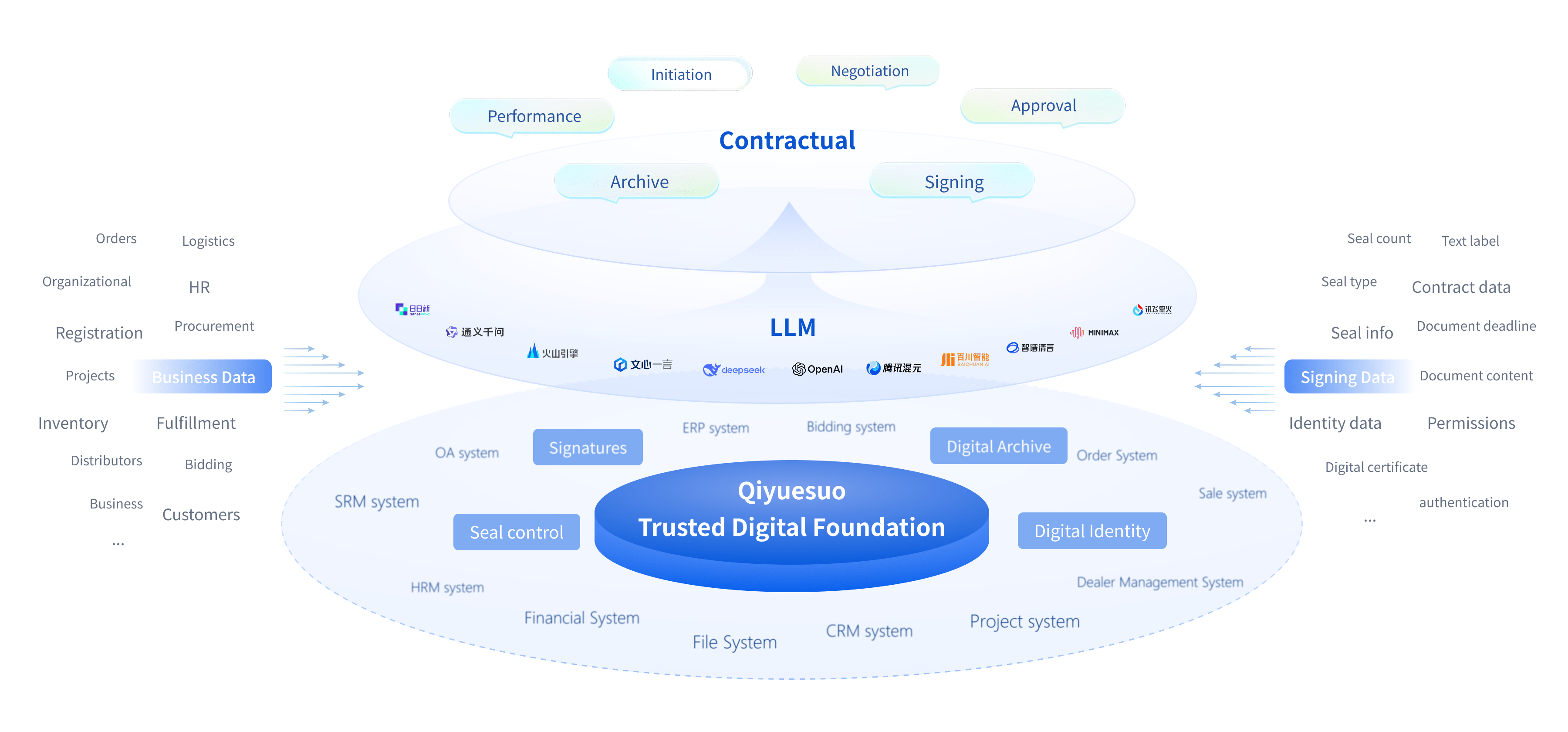
Intelligent Services for Contract Drafting, Review, Signing, and Management
Hundreds of intelligent services available to automate tedious and repetitive contract tasks.
Intelligent Drafting
Provides standardized templates to enable automatic document generation, intelligent text data extraction, and collaborative content editing — helping automate the contract drafting process for standardized, accurate, and efficient contract creation.
- AI Automatically Generates TemplatesAutomatically generate contract text based on contract name and keywords.
- Electronic Template Library
- Edit Tracking
- Text Comparison
- Contract Clause Library
- Accurate Information Extraction
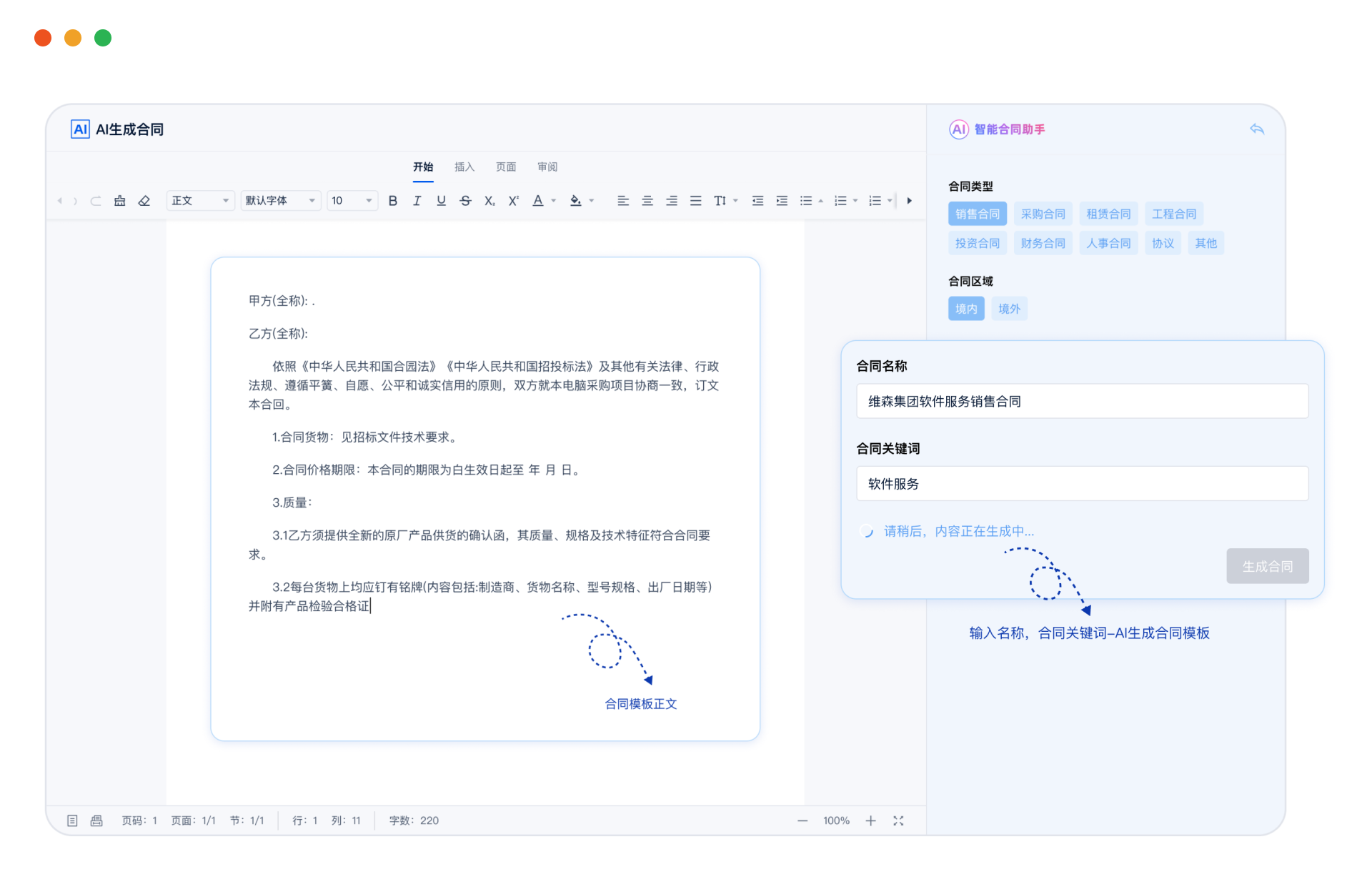
Intelligent Drafting
Provides standardized templates to enable automatic document generation, intelligent text data extraction, and collaborative content editing — helping automate the contract drafting process for standardized, accurate, and efficient contract creation.

AI Automatically Generates Templates
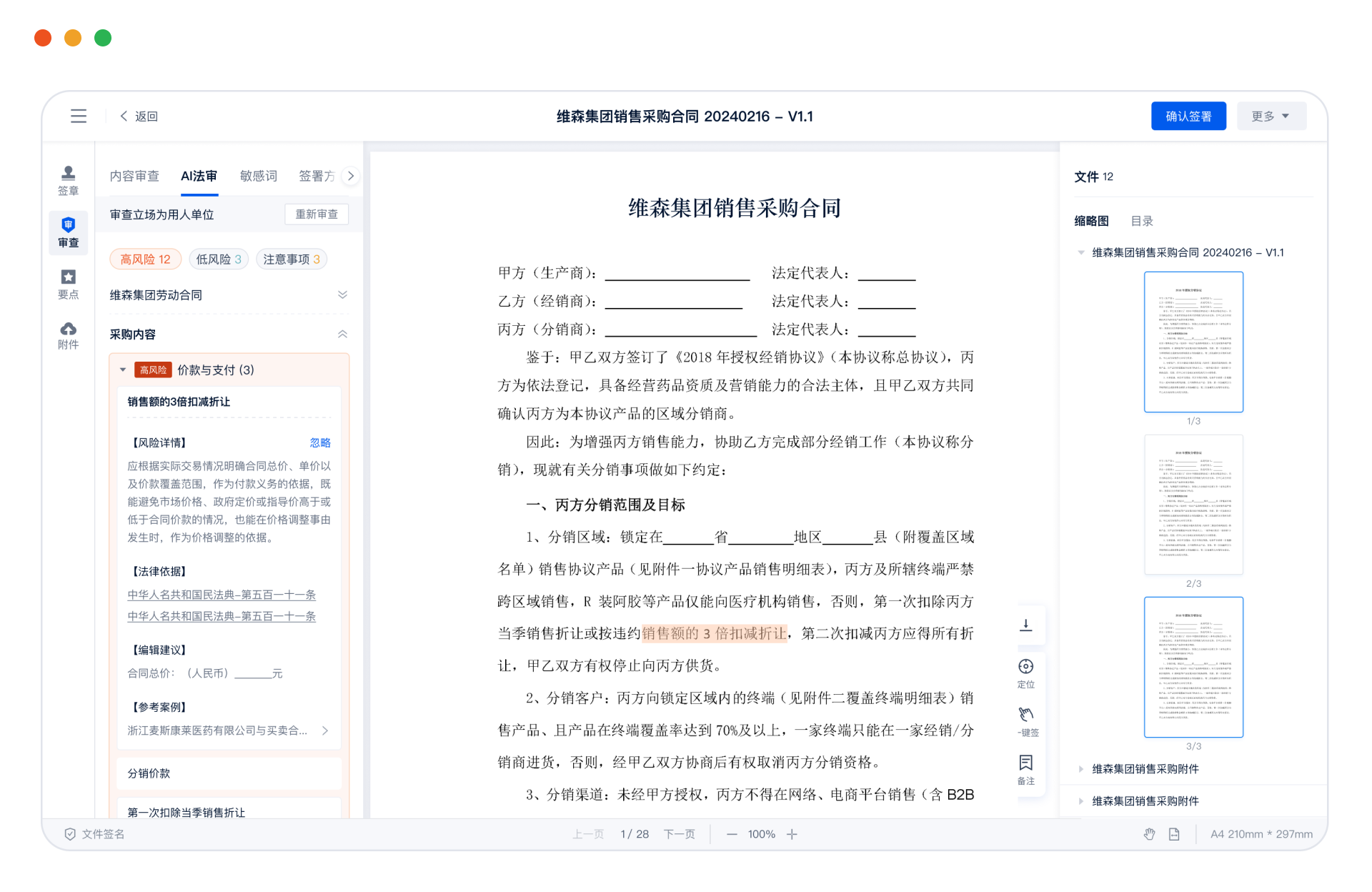
Auxiliary Approval
Leveraging natural language processing and machine learning techniques, the system automatically identifies, extracts, and evaluates key contract content and risk points, helping approvers quickly grasp essential contract information and supporting accurate review and decision-making.
- AI Intelligent Legal ReviewReal-time detection of clause conflicts, missing rights and obligations, and other risk points, with suggested revisions provided.
- Contract Content Review
- Sensitive Data Masking
- Collaborative Consultation Editing
- Business Information Retrieval
- Automatic Keyword Detection
Auxiliary Approval
Leveraging natural language processing and machine learning techniques, the system automatically identifies, extracts, and evaluates key contract content and risk points, helping approvers quickly grasp essential contract information and supporting accurate review and decision-making.

AI Intelligent Legal Review
Compliant Signing
Build diverse signing scenarios tailored to the organization’s signing habits, ensuring end-to-end trustworthiness from signer identity and intent to signing results. Continuously improve signing efficiency while guaranteeing compliance and legal validity.
- Batch SigningMultiple documents are checked and signed in batch signing at one time, without repeated operation.
- Signature Handwriting Verification
- Intelligent Seal Recommendation
- Automatically Identify Signing Locations
- One-Click Cross-Page Seal Application
- GPS Positioning for Signing
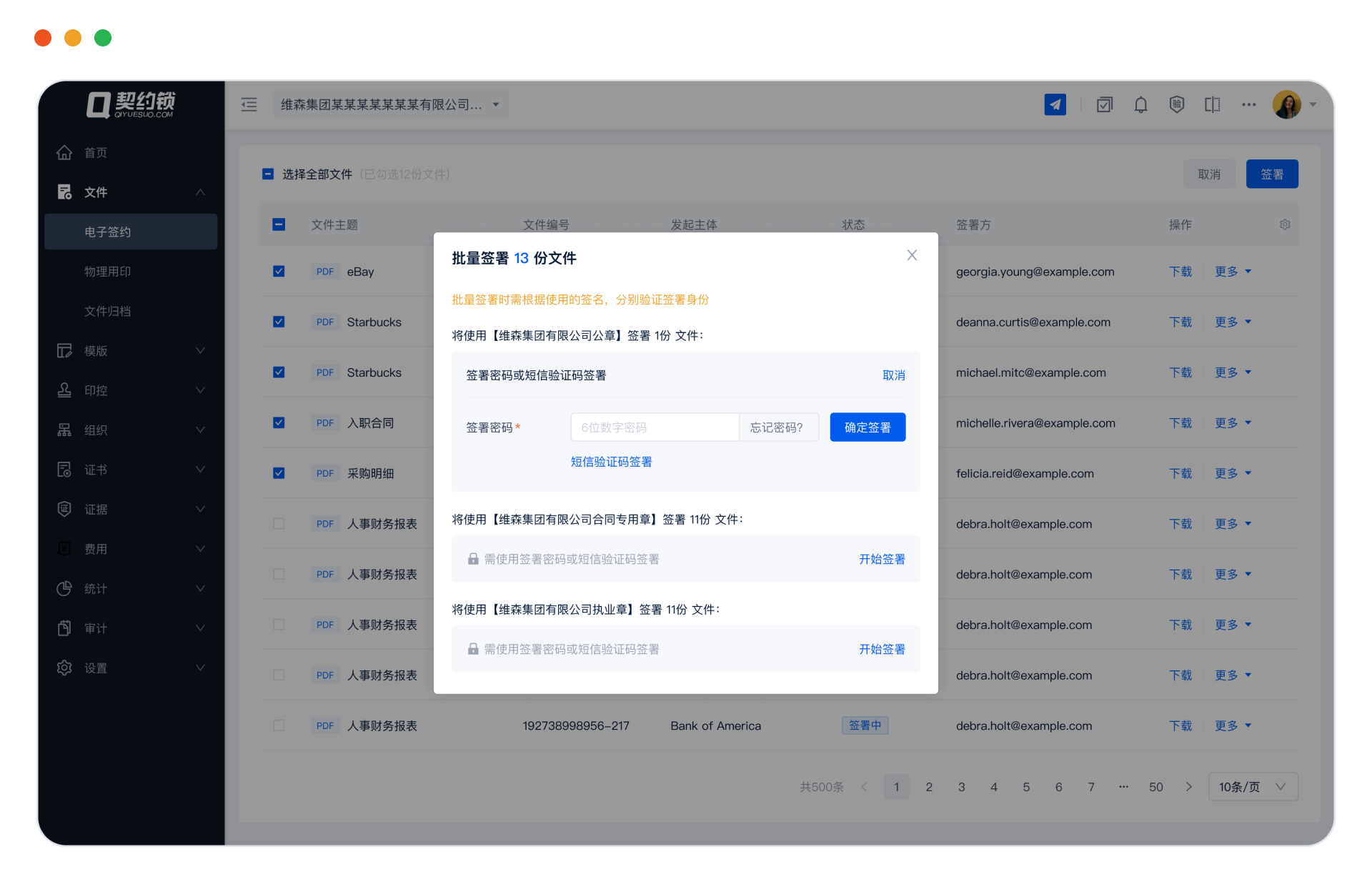
Compliant Signing
Build diverse signing scenarios tailored to the organization’s signing habits, ensuring end-to-end trustworthiness from signer identity and intent to signing results. Continuously improve signing efficiency while guaranteeing compliance and legal validity.

Batch Signing
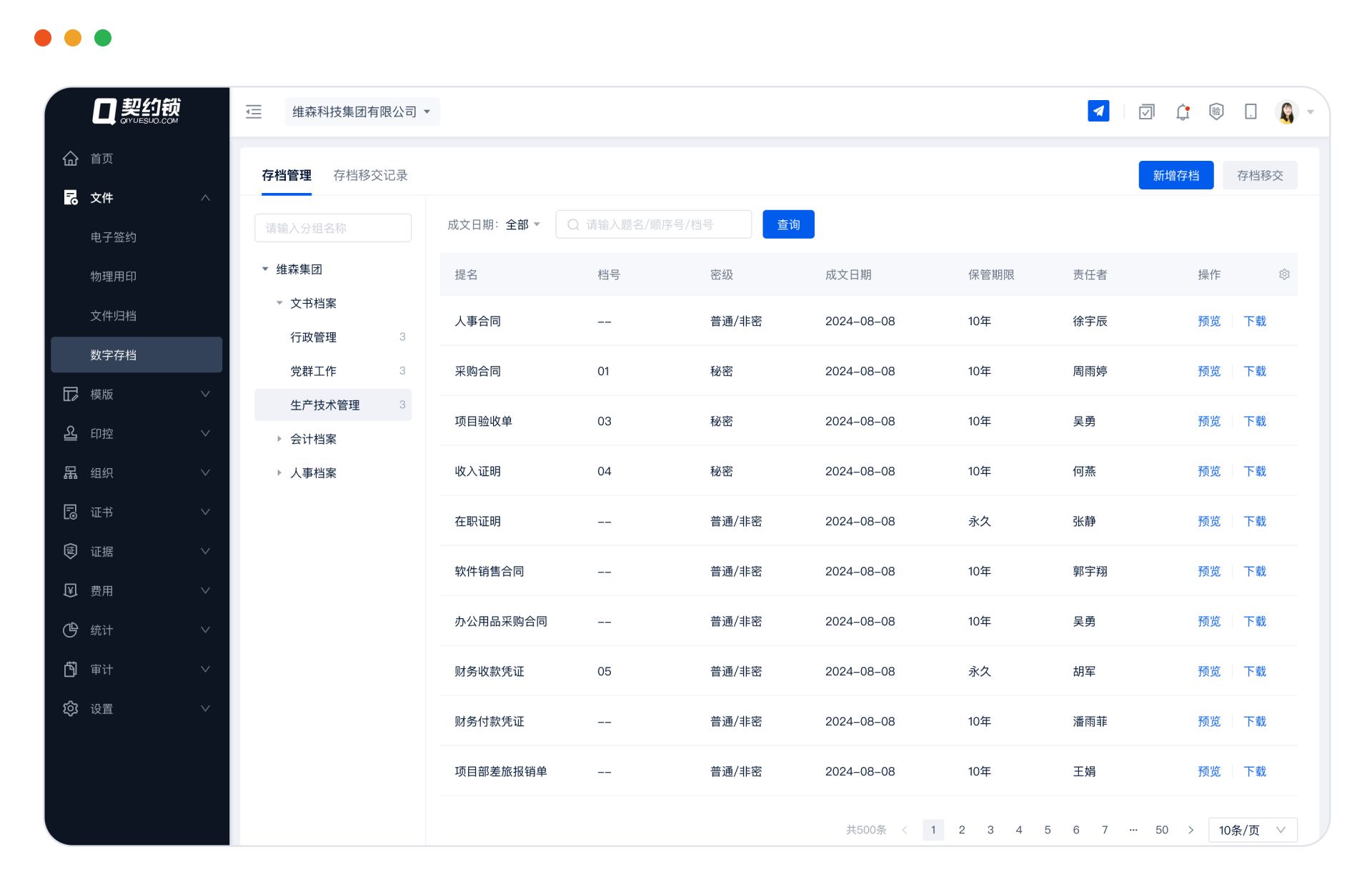
One-Click Archiving
Automatically classify business operations, contracts, seals, and other data throughout the contract lifecycle based on archive management rules; enable one-click archiving with tamper-proof protection. Archived files support intelligent retrieval and are accessible anytime.
- Automatic File ArchivingSigned documents are automatically classified and archived, stored for a long time, and can be accessed at any time.
- Contract Expiration Reminder
- Intelligent File Retrieval
- One-Click Transfer and Archiving
One-Click Archiving
Automatically classify business operations, contracts, seals, and other data throughout the contract lifecycle based on archive management rules; enable one-click archiving with tamper-proof protection. Archived files support intelligent retrieval and are accessible anytime.

Automatic File Archiving
Meet the intelligent management needs of various business documents.
Qiyuesuo provides customized contract management solutions for different business needs, supporting the end-to-end intelligent and digital transformation across various industries.
Basic Office
Industry-Specific Scenarios
Employment Contracts
Intelligently generate labor contracts and onboarding document signing workflows in batches; support face scan and QR code signing, with automatic collection and archiving of documents and contracts, plus company batch stamping.
Intelligently generate labor contracts and onboarding document signing workflows in batches; support face scan and QR code signing, with automatic collection and archiving of documents and contracts, plus company batch stamping.
Purchase Contracts
Face recognition is used during supplier screening to verify identity, while business registration data is intelligently captured to ensure full compliance throughout the process; batch electronic contract generation and remote mobile signing are supported.
Face recognition is used during supplier screening to verify identity, while business registration data is intelligently captured to ensure full compliance throughout the process; batch electronic contract generation and remote mobile signing are supported.
Sales Contracts
Electronic templates are automatically applied and drafted; sales data from business systems is auto-captured to intelligently complete contract information entry and quickly initiate online signing.
Electronic templates are automatically applied and drafted; sales data from business systems is auto-captured to intelligently complete contract information entry and quickly initiate online signing.
Financial Vouchers
Integrate with financial systems to generate electronic vouchers with templates as needed during payment processes, automatically complete stamping, and issue PDF electronic voucher files in real time.
Integrate with financial systems to generate electronic vouchers with templates as needed during payment processes, automatically complete stamping, and issue PDF electronic voucher files in real time.
Certificate Documents
Commonly used standardized proof documents across industries, such as employment certificates, community certificates, enrollment proofs, etc., can be self-applied anytime, anywhere with one-click document generation and instant stamping.
Commonly used standardized proof documents across industries, such as employment certificates, community certificates, enrollment proofs, etc., can be self-applied anytime, anywhere with one-click document generation and instant stamping.
Franchise Contracts
For franchise application, authorization, renewal, and other processes, quickly verify franchisee identity, enable smart SMS signing, and automatically stamp formatted documents, improving franchise processing efficiency.
For franchise application, authorization, renewal, and other processes, quickly verify franchisee identity, enable smart SMS signing, and automatically stamp formatted documents, improving franchise processing efficiency.
Employment Contracts
Intelligently generate labor contracts and onboarding document signing workflows in batches; support face scan and QR code signing, with automatic collection and archiving of documents and contracts, plus company batch stamping.
Intelligently generate labor contracts and onboarding document signing workflows in batches; support face scan and QR code signing, with automatic collection and archiving of documents and contracts, plus company batch stamping.
Financial Vouchers
Integrate with financial systems to generate electronic vouchers with templates as needed during payment processes, automatically complete stamping, and issue PDF electronic voucher files in real time.
Purchase Contracts
Face recognition is used during supplier screening to verify identity, while business registration data is intelligently captured to ensure full compliance throughout the process; batch electronic contract generation and remote mobile signing are supported.
Sales Contracts
Electronic templates are automatically applied and drafted; sales data from business systems is auto-captured to intelligently complete contract information entry and quickly initiate online signing.
Certificate Documents
Commonly used standardized proof documents across industries, such as employment certificates, community certificates, enrollment proofs, etc., can be self-applied anytime, anywhere with one-click document generation and instant stamping.
Franchise Contracts
For franchise application, authorization, renewal, and other processes, quickly verify franchisee identity, enable smart SMS signing, and automatically stamp formatted documents, improving franchise processing efficiency.
Hundreds of integrated software application services
Qiyuesuo offers API/SDK interfaces supporting proactive and passive integration methods, enabling flexible expansion of intelligent digital contract management scenarios.
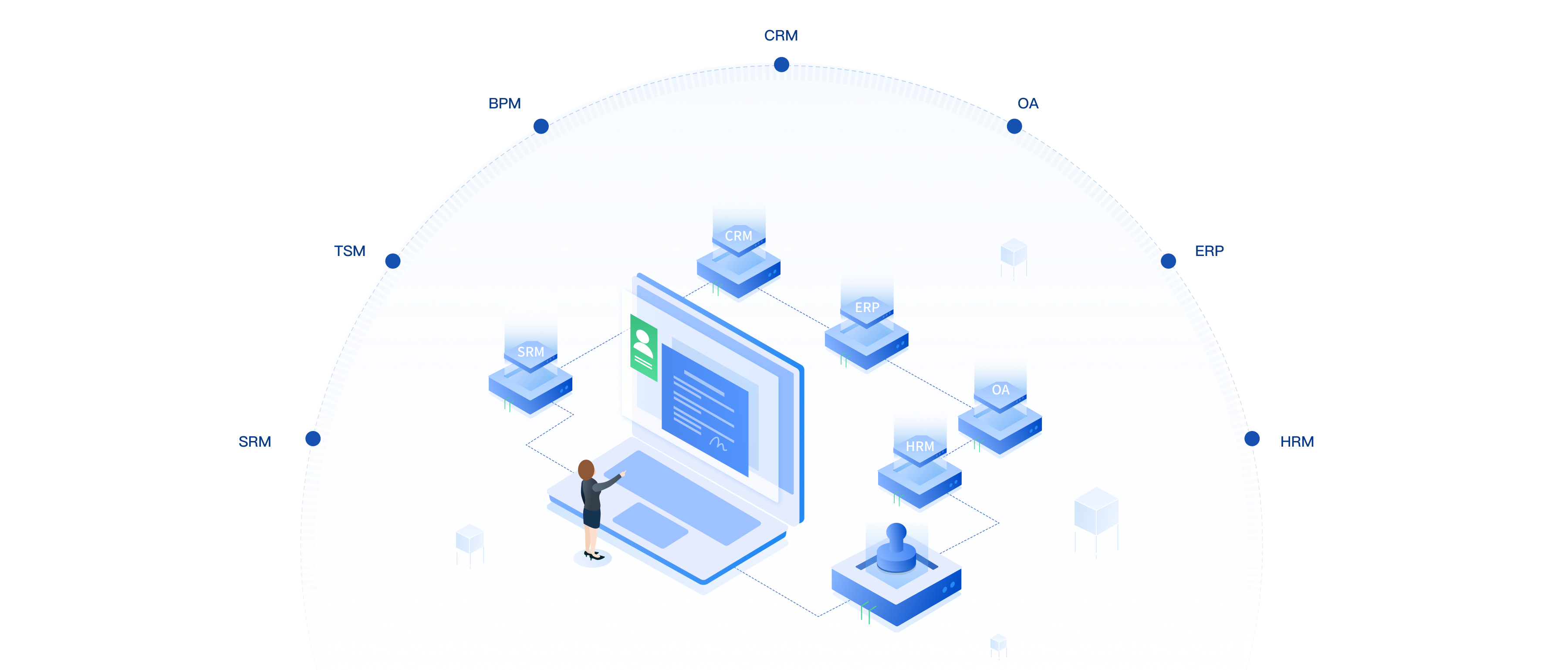
Value of Intelligent Contract Management
Simplify contract management processes to boost efficiency and security while reducing costs.
Traditional Procedures
Drafting-Time consuming and prone to errors
Manual drafting and input of information such as signatories and amounts are prone to errors, necessitating repeated proofreading and printing.
Approval-Missed Issues in Blind Review
Revisions to contracts based on all parties' opinions lack effective records during the process; key information has to be reviewed repeatedly, making it prone to omissions and carrying high risks.
Signing-Inefficient and Constrained
Contracts must be mailed or signed in person at a designated location; remote signing across different places is cumbersome, with all manual operations leading to heavy workload.
Archiving-Tedious and Cumbersome
Manual sorting, classifying, and archiving of documents require substantial human labor and time, leading to easy accumulation and difficult retrieval.
Intelligent Management
Drafting-Precise and Efficient
AI automatically expands and generates documents by inputting key information, with key data associated, automatically entered, and synchronously updated to reduce manual intervention.
Approval-Intelligent Risk Control
Automatic extraction of keywords and sensitive terms, legal risk detection with suggested revisions, enabling efficient approval and precise risk control.
Signing-Compliant and Convenient
SMS reminders for signing, real-name authentication to ensure identity, support for mobile signing, one-click stamping for large batches of documents, and secure and compliant signing.
Archiving-Automatic Archiving
All document data are automatically classified and archived, and can be transferred to the file system with one click. The entire process is tamper-proof, and self-service retrieval and query are available at any time.

Why Choose Qiyuesuo
 Intelligent Service Support
Intelligent Service Support
Qiyuesuo's products have been fully integrated with various AI large models such as DeepSeek and Baidu Smart Cloud, and can be connected to other AI technologies according to customer needs. This continuous integration aims to enhance the efficiency of electronic document initiation, approval, signing, and review, ensuring that contract-related work is carried out securely and compliantly.
 Extensive Software Integration Experience
Extensive Software Integration Experience
Qiyuesuo has integrated with hundreds of software applications, including various management systems such as OA, ERP, HRM, SRM, CRM, HIS (hospital information systems), and archive systems. It can expand intelligent contract management scenarios based on different business needs, enabling full-process digital and intelligent transformation for enterprises.
 Diverse E-signature Scenarios
Diverse E-signature Scenarios
Qiyuesuo has achieved integrated applications with hundreds of software systems, including various management software such as OA, ERP, HRM, SRM, CRM, HIS hospital information systems, and archive systems. It can expand intelligent contract management scenarios according to different business needs, helping businesses achieve full-process digital and intelligent transformation.
 Leading Mid-to-Large Organizations
Leading Mid-to-Large Organizations
Qiyuesuo serves a large customer base of mid-sized and large organizations, including Fortune 500 companies, China's Top 500 enterprises, leading private Chinese corporations, as well as renowned institutions across multiple industries - hospitals, universities, food & beverage, apparel, automotive, finance, inspection & testing, agriculture, engineering, catering, energy & chemicals, with extensive case studies demonstrating our expertise.
Professional Consultants Available to Answer Your Questions or Provide Demonstrations.
Submit
Hotline
on line
Demo

 沪公网安备 31011202012092号
沪公网安备 31011202012092号